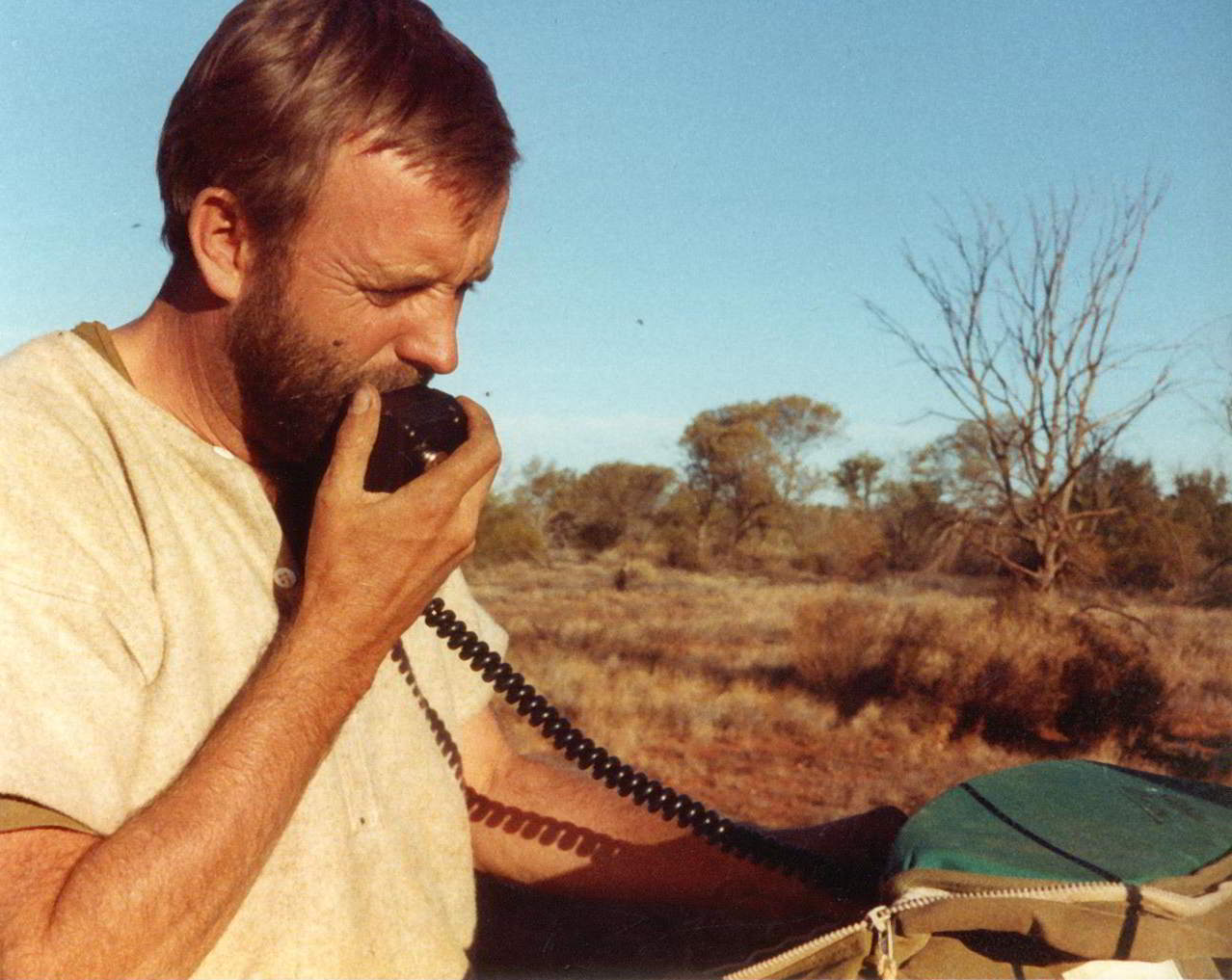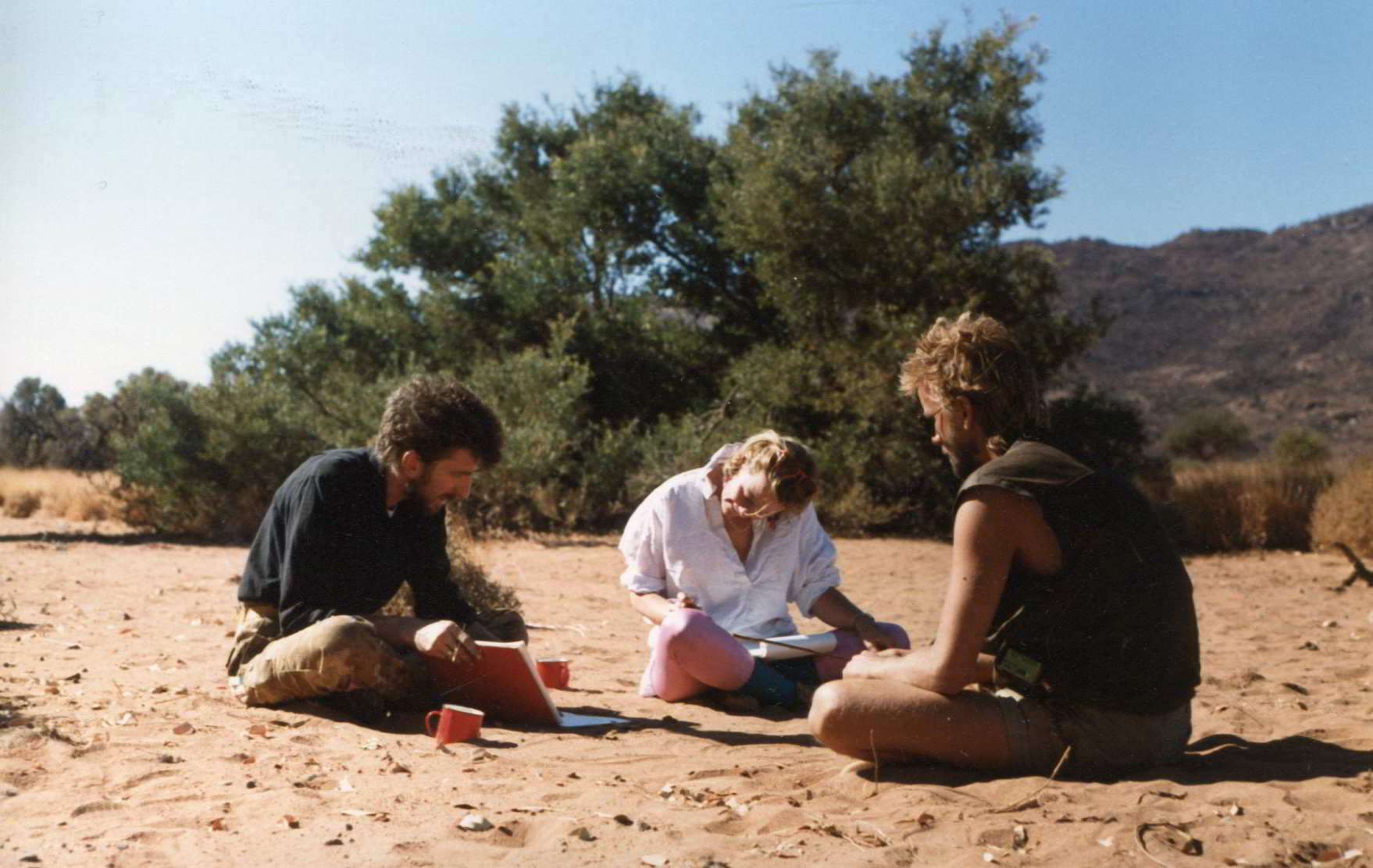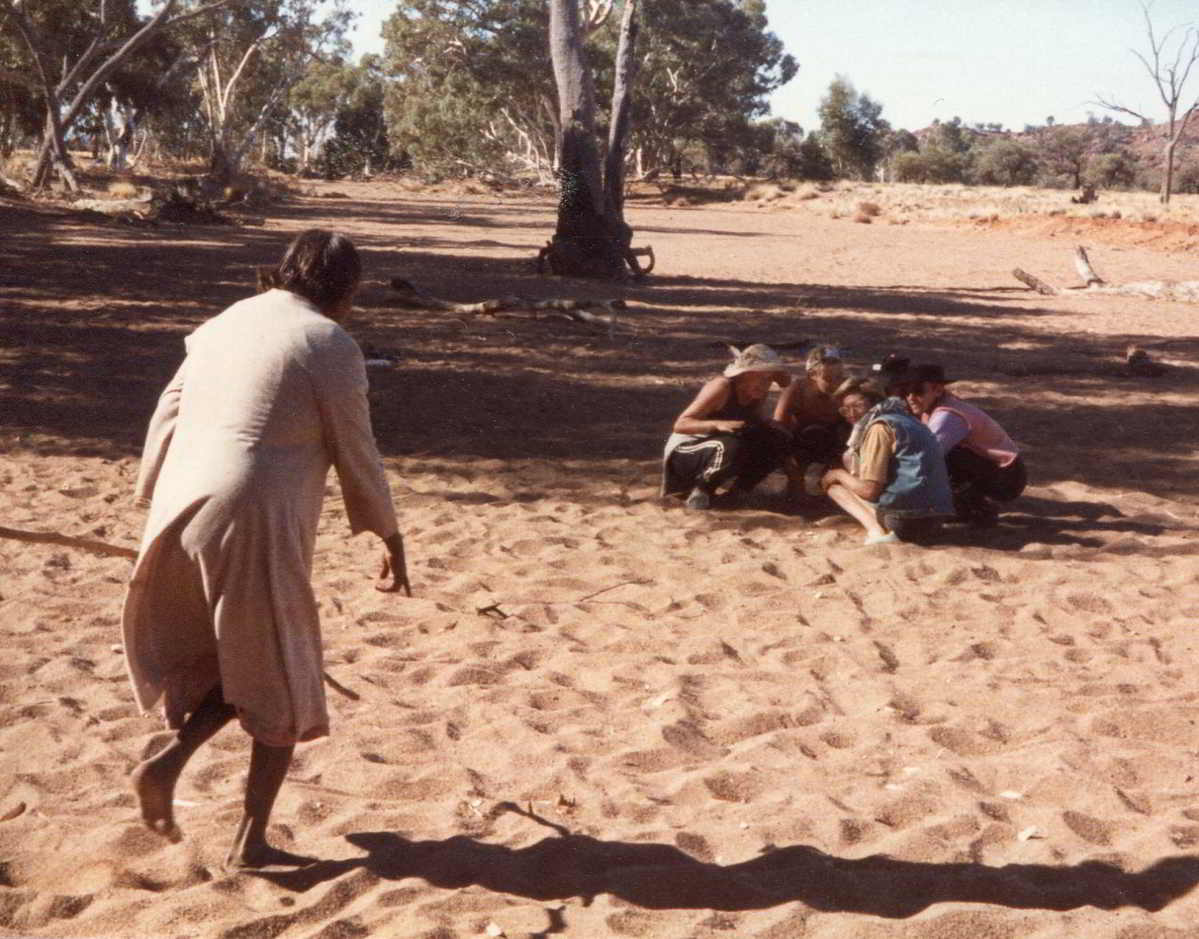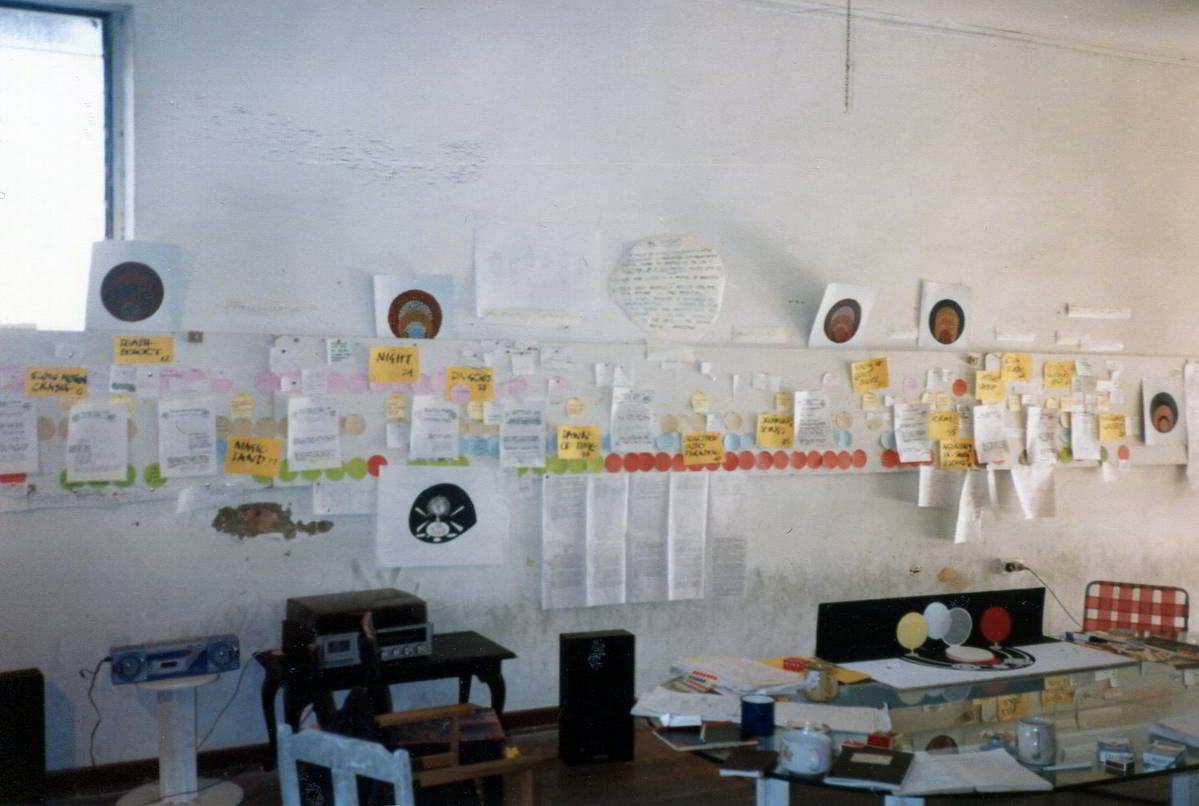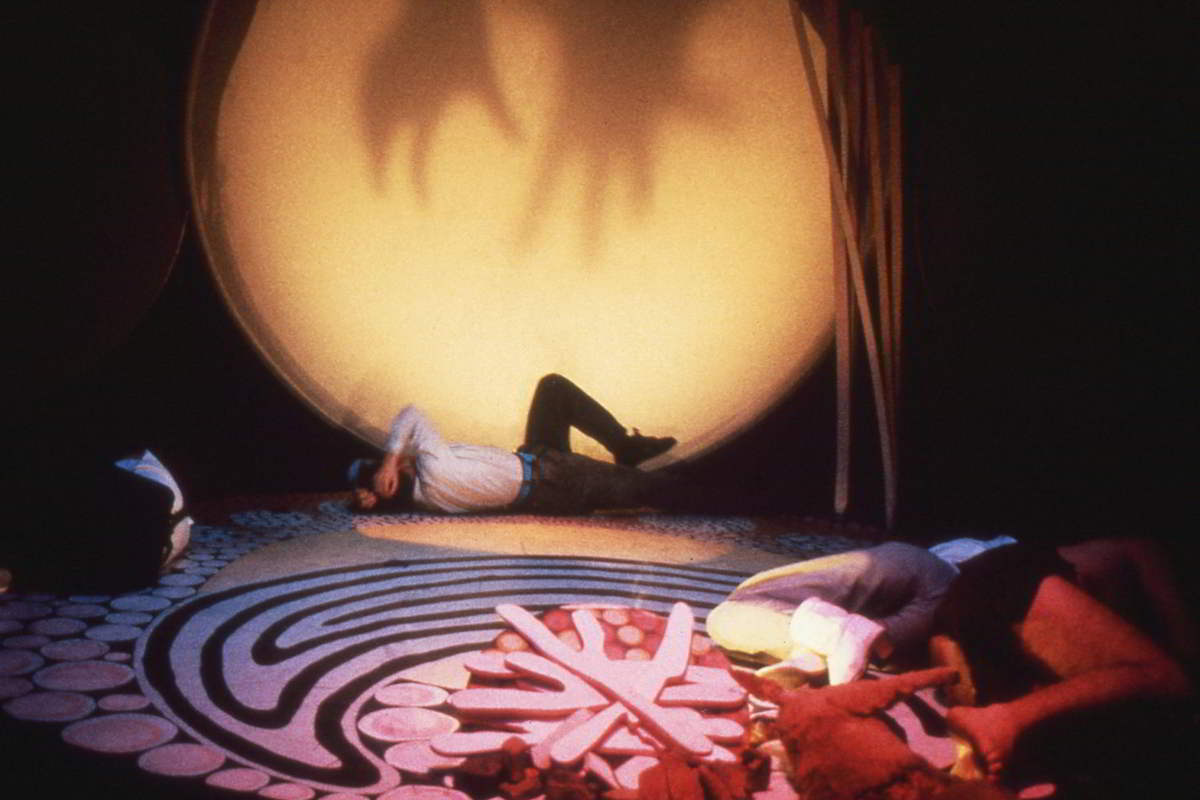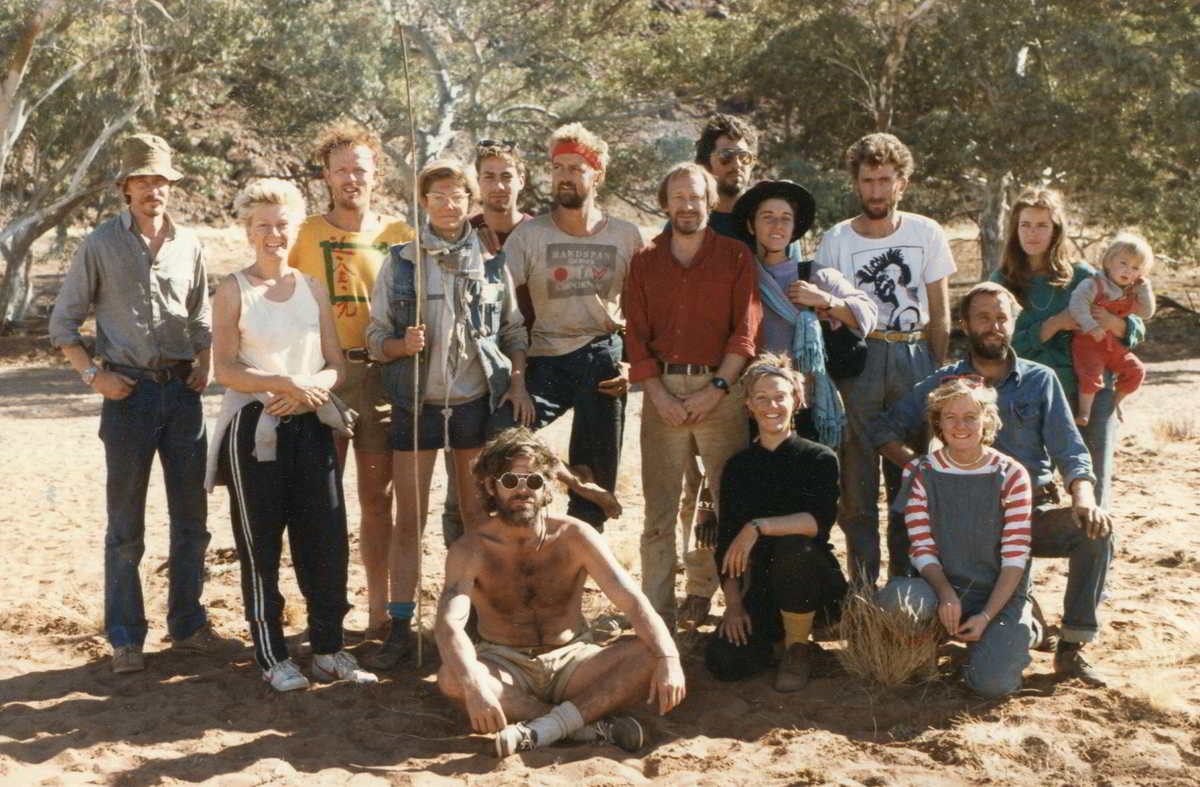| Premiere | 21 August, 1985 |
| Venue | U2 Universal Theatre, Fitzroy, Victoria |
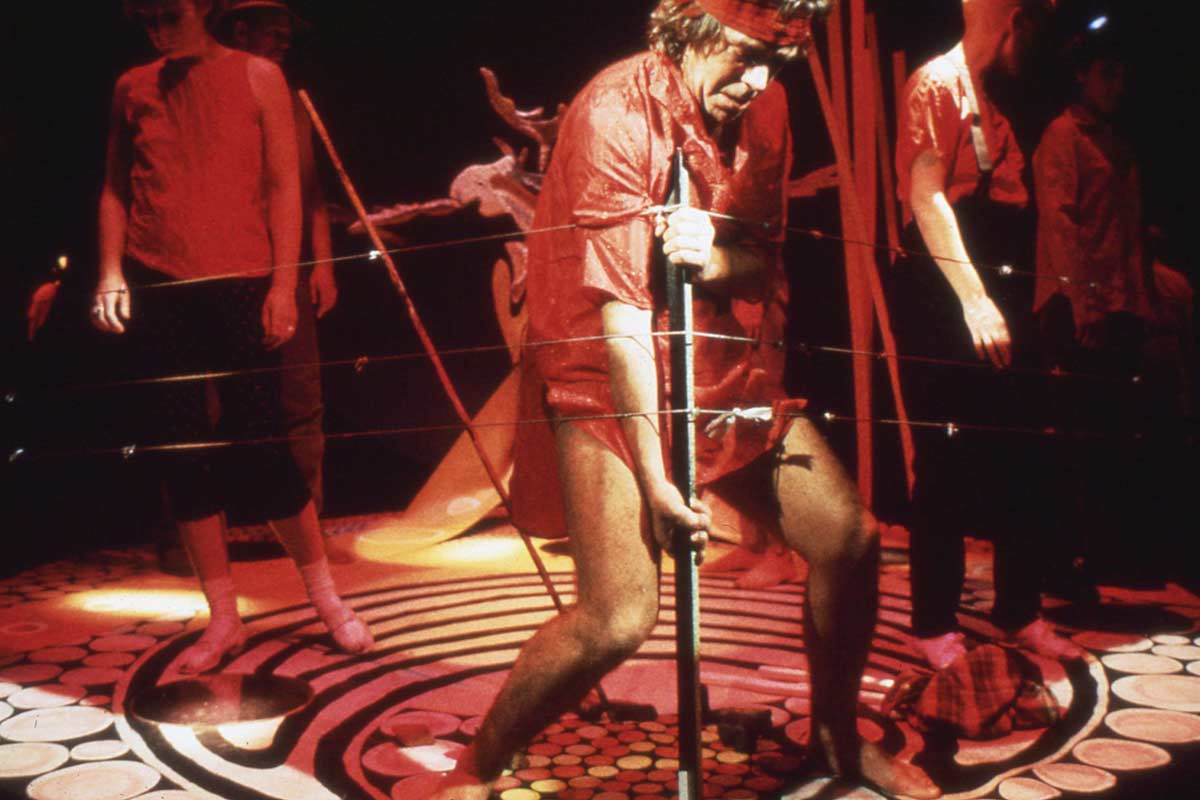
THE HAUNTED, billed as a 'visual search for cultural identity,' focused on Australia’s 200 year old collision of cultures and our difficulty in coming to terms with the indigenous history of our adopted land.
The work was created by Handspan after a lengthy period of international touring with Secrets (1983-85) during which company artists found themselves Australian cultural ambassadors. This unwittingly assumed mantle revealed their collective ignorance of Australia’s indigenous history, and inspired their interest in newly emerging contemporary perspectives of their colonial past. Their experience of discovery, itself became the basis of the company's new play.
THE HAUNTED was devised by the Handspan ensemble with director Peter Oyston, composer Gregory Sneddon, designer Ken Evans, lighting designer Philip Lethlean, producer/dramaturg Helen Rickards and the original cast.
The production premiered in Melbourne at the 1985 Next Wave Festival and then toured to the Breakout Festival in Alice Springs.
Finding the threads
The initial stimulus for the work was the story of Derrimut, an aboriginal boy from the Melbourne area. His friendship with settler, Willie Watkins in 1836, if it had not been betrayed, was the kind of relationship that might have built a very different Australia. Peter Charlton, Melbourne playwright and director, brought the story and the early writings of contemporary Australian historian, Henry Reynolds 1 to Handspan and worked with the company to begin to develop a collaborative perspective of Australia's cultural roots towards its visualisation on stage.
The project was further influenced by the emerging review of Australia’s colonial and pre-colonial history that was brought to public recognition and debate during Victoria’s Sesquicentenary celebrations (1985) and the, then forthcoming, Australian Bicentenary commemorations (1988).
A fortuitous meeting 2 in Alice Springs between Ken Evans and Central Australian cultural advisor, Clive Scollay, led to the opportunity for the evolving work to be further researched in a cultural exchange residency at Angajta outstation in South Australia. It led too, to Handspan’s engagement of Peter Oyston to develop and direct the work through a 'Theatre Laboratory' experience based on Peter Brook’s methods that created The Conference of the Birds in Africa 3 , long admired by Handspan artists.
This process substantially altered the play’s evolution. Charlton was no longer interested in the work, and it became, in Oyston’s words:
Two journeys – to find one’s personal responsibility and fear, and to search for the ghost of this aboriginal youth, Derrimut ... I believe we are haunted by not be able to come to terms with the calculated, fastidious removal of an entire culture from this country
Melbourne, August 1985
Desert Dreaming and Practice
Guided by Clive Scollay, Handspan artists, Oyston and composer, Gregory Sneddon spent two weeks in Australia’s central desert, in June 1985 where Pitjantjatjara elders, Nganyintja, Ilyatjari and Tjilari shared their traditional culture, stories, bush tucker and inma at Angatja Outstation. The Elders generously gave the company permission to reference their stories, memories and landscape in the play, and record their voices and music for inclusion in its soundscape.
The desert experience was an eye-opener for all, and the company’s newly awakened awareness of, and curiosity about, Australia’s indigenous past became the foundation for the completed work.
Performer Avril McQueen recalled the importance of the experience when the company returned to Melbourne:
Handspan and the Pitjantjatjara Anangu met between the extremes of black and white Australia – culturally, educationally and philosophically. It was a rare opportunity to share stories and experiences and the interpretation of both
During the residency, the company discussed and recorded their individual and collective responses to the landscape and the material and influences to which they had been introduced by their host community. Performance ideas were workshopped with Handspan's white generic Baby puppet 4
exploring the landscape and its unknown and ancient stories. (see also White Mother)
Peter Oyston developed the Theatre Laboratory framework for the desert residency. Isolated from the main camp, the performers. 'in character', spent 3 days and nights immersed in dramatic improvisation to explore their reactions to group survival in an unknown environment. Oyston dropped into the scenario from time to time to introduce stimulus directives for improvisation, and observed the 'living theatre' activity overtly and covertly throughout. This intense workshop informed the characters and narrative through line of the play.
The project activity was filmed by documentary company Kestrel Films, who shared the desert retreat and recorded sound with Greg Sneddon for the play's soundscape. Independently, Richard Neville and his film crew from The Ray Martin Show joined the final night Inma hosted by the Anganu community. It was Handspan's last night in the desert and lively white fella debate around the visitors' campfire added another perspective.
--
To create The Haunted, its director, Peter Oyston and the company spent two weeks out in the tribal country of Australia’s centre, learning not about Aboriginal people but from them – about themselves. This is the play’s special achievement that these urban goldfish, as it were, have been able to climb out of their bowl, come to know it well from a new perspective, and then fashion all this experience into some sort of communicable form
The Play
THE HAUNTED aimed to represent its narrative through images and sounds of the landscape in which the play was conceived. It was the place through which random white fella characters sought to find their way after a head-on encounter with the unknown environment.
The play opened with the entrance and crash of a remote control model Toyota Landcruiser into the landscape. Surrounded by the dots, circles and clumped, straight spinifex of the landscape, the dazed passengers (actors) emerged to stagger, squabble and brawl. Their urban sensibilities and backgrounds affronted and confronted by the unknown surroundings. The land itself, represented in imagery and sound, settled them - all but one found new perspectives.
I was always involved, often engrossed. There’s a shower of light, collected in mirrors, that is simply beautiful, an overwhelming soundtrack where Aboriginal voices meld with synthesised sound … and a whole world of inanimate objects (including a suitcase!) that mysteriously come to life.
No indigenous performers were in the work other than in recorded voices on the soundtrack, nor were there were onstage representations of aboriginal people or appropriation of indigenous stories. The play attempted to express the awakening, the questions, the confusion and awe provoked by the company's own experience in the desert, and to contextualise its concepts for provocative theatrical performance.
Reactions
The concept and style of the work was widely applauded:
The play could be described as being ‘pro’ Aboriginal people but we are not asked for pity, or even sympathy. Rather it is the Aboriginal way of experiencing the land as a magical and mysterious mother that is offered as an alternative to seeing it as something to be either ruthlessly exploited or admired on a coach tour
The technical aspects of this production are astounding. From the very first loud (and completely unexpected) crash, the special effects kept me spellbound. It was as though ad dream was actually unravelling before me. A beautiful marriage of sound and light makes this production unforgettable… under the special effects there is a multi-layered tapestry of ideas which should get anyone thinking
The creation and development of THE HAUNTED was an ambitious undertaking and one fraught with intensity, uncertainty and some confrontation. Oyston had little experience in theatre of imagery; Handspan artists had determination but lacked confidence in the narrative strength of their ideas; appropriate recognition of indigenous material was complex; the company ensemble expanded to include former Victorian College of the Arts students trained by Oyston, and although willing participants, they too were unversed in theatre of image; and the production timeline was incredibly short. See The Haunted Production Schedule 1985.
THE HAUNTED opened at Melbourne’s first Next Wave Festival and toured to the Breakout Festival in Alice Springs. It was received with acclaim for its images and concepts but its underlying narrative shape and characters were insubstantial and the general consensus from critics and company alike was that it was extraordinary but needed further work.
Geoffrey Hutton, reviewer at The Australian wrote:
This is group theatre as one might guess from the shape, or shapelessness of the play. The goodie (I think) is Ian Mortimer and the baddie, Andrew Hansen. In such a production it is difficult to be sure …This exercise in historical and contemporary propaganda has a strangely miasmic effect. We are in the land of the spirits and although the symbolism is obscure, we gradually learnt to accept it ... Handspan is an adventurous company and this is an adventure.
Leonard Radic at The Age in Melbourne, compared it with Handspan's previous work and hoped it would develop further:
The Haunted is an imaginative but not always clear or accessible cry of protest at the barbarity practised by the white settlers against the Aborigines...At the moment it is not so much a finished work as a first draft or work in progress.
By the time it opened in its second season in Alice Springs, attended by the Anangu community its had run in and evolved further:
Handspan has avoided using dialogue in the conventional theatrical manner. The message is too big for words except as a small aspect of a broader assault using stylised body movements and brilliantly presented symbolic props. …for those with ears to hear it was a timely reminder that this enchanted country has more to offer us than the possibility of unlimited financial growth
The play’s unique design and poignantly haunting soundtrack were memorable and its concepts, unresolved though they may have been, were ground-breaking subject matter for the stage of its time.
--
Handspan had hoped it would be another work for international touring, and it may so have eventuated but the company was unable to afford its further development, or fit a re-working schedule into its forthcoming program, Ground-breaking but incomplete, THE HAUNTED lapsed from the company repertoire after only two seasons.
Footnotes
| Creative team | |
|---|---|
| Devised & developed | Peter Oyston and the company |
| Director | Peter Oyston |
| Designer | Ken Evans |
| Producer/Dramaturg | Helen Rickards |
| Lighting designer/operator | Philip Lethlean |
| Composer | Gregory Sneddon |
| Cultural Liaison | Clive Scollay |
| Puppet makers | Philip Millar, Dorothy Rickards (Kangaroo puppet) |
| Manipulation director | Peter J.Wilson |
| Script Research assistant | Joy Dewey |
| Performers | |
|---|---|
| Niece | Carmelina Di Guglielmo |
| Brian | Andrew Hansen |
| Robyn | Andrea Lemon |
| Helmut | Ian Mortimer |
| Katrina | Avril McQueen |
| Erica | Lizz Talbot |
| Sound track voices | Nganyinta, Tjilari, Clive Scollay, Carmelina Di Guglielmo, Andrew Hansen, Andrea Lemon, Ian Mortimer, Avril McQueen, Lizz Talbot |
| Production team | |
|---|---|
| Wardrobe | June Laurie |
| Scenic painting | Gina Wardlaw, Pierangela Giansiracusa |
| Production assistants | Jodi Cummings, Chris Pawlowicz, Shane Walls, Simone Speechley, Jo Coates. |
| Production crew | Laurel Frank, David Shepherd |
| Sound Engineer | Doron Kipen |
| Stage manager | David Hope |
| Film crew | Kestrel Film Productions: John Richardson, David Morgan, Terry Carlyon, Ian Cameron |
| Publicity | Jude Bourguignon |
| Graphics | John Dickson |
| Seasons | |
|---|---|
| 21 August – 1 September, 1995 | U2 Universal Theatre, Fitzroy VIC, Next Wave Festival |
| 9 - 11 October, 1985 | Araluen Cultural Centre, Alice Springs NT, Breakout Festival |
| Total performances | 37 |
| Total audience | 3,265 |
Mainstage:
